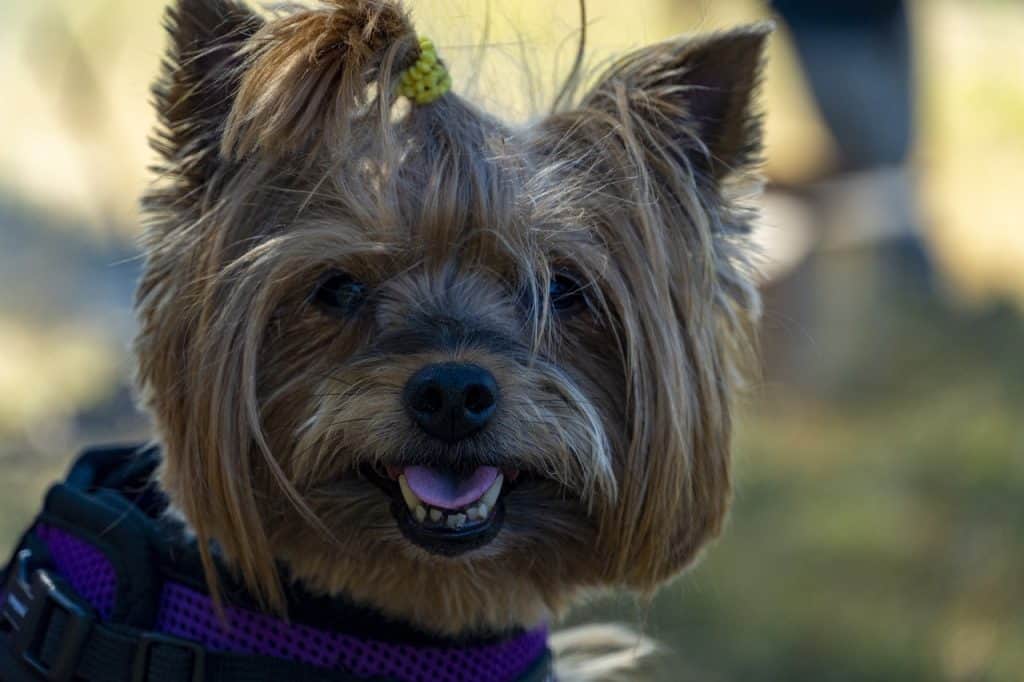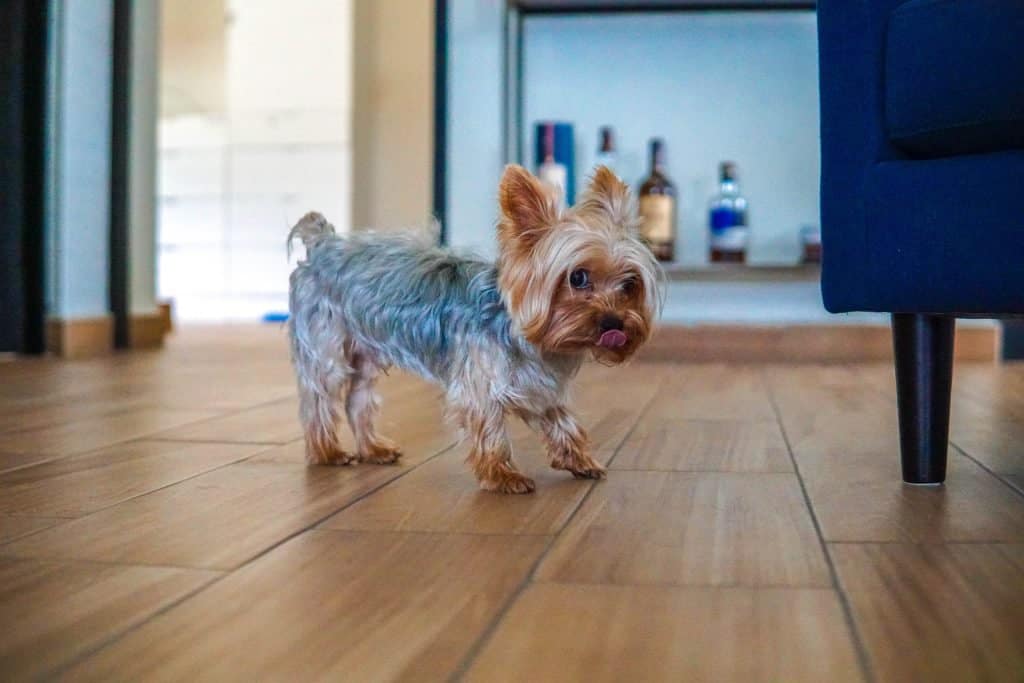Yorkshire Terriers, or Yorkies as they are affectionately known, have captured the hearts of dog lovers worldwide with their charming personalities and irresistible looks. One of the most enchanting phases in a Yorkie’s life is when they transition from their fluffy puppy coat to their sleek adult coat. If you’re a proud Yorkie owner or an eager enthusiast, you might wonder: when do Yorkies lose their puppy coat? Join us as we explore the fascinating journey of when Yorkies lose their puppy coat, unveiling the beauty beneath those soft, fluffy layers.
TL;DR: When Do Yorkies Lose Their Puppy Coat?
Yorkies typically lose their puppy coat between six to twelve months of age as they transition into their adult coat. The puppy coat, which is soft, fine, and often dark in color, gradually gives way to a thicker, coarser, and more vibrant adult coat. The transition may vary for each pup, but by the age of one to two years, they will have fully developed their adult coat. Regular grooming is essential during this process to maintain their coat’s health and appearance.
About the Yorkshire Terrier Breed
Before delving into the fascinating world of Yorkie coats, let’s talk about the breed. Yorkshire Terriers, often called Yorkies, are a small and beloved toy breed known for their elegance, intelligence, and spirited personalities. They used to be among the most popular dog breeds, although their fame has decreased recently.
Origin of Yorkies
Yorkshire Terriers have a rich history dating back to the 19th century in England. They were originally bred for catching rats in textile mills, but their charm and beauty quickly gained attention, leading to their popularity as companion dogs.
Appearance of Yorkies
Yorkies are small, typically weighing between 4 to 7 pounds (1.8 to 3.2 kg) and standing about 8 to 9 inches (20 to 23 cm) tall at the shoulder. They have a compact body with a straight, glossy, and luxurious coat in various colors, including black, tan, blue, and gold.

Temperament of Yorkies
Yorkies are known for their confident, aggressive, and independent personalities despite their small stature. They are often described as energetic, alert, and courageous. Yorkies are highly loyal to their owners and can form strong bonds. They make excellent companion dogs and thrive on human companionship.
Intelligence and Trainability of Yorkies
Yorkies are intelligent and quick learners. They can excel in obedience training and learn various tricks with proper training and positive reinforcement techniques. However, they may sometimes exhibit stubbornness, so consistency and patience are critical in their training.

Exercise and Activity of Yorkies
Despite their small size, Yorkies have moderate exercise needs. Daily walks, playtime, and mental stimulation through interactive toys or training sessions are essential to keep them physically and mentally stimulated. Yorkies can adapt well to apartment living as long as they receive regular exercise and attention.
Grooming Needs of Yorkies
The Yorkshire Terrier’s long, silky coat requires regular grooming to keep it healthy and tangle-free. Daily brushing is recommended to prevent matting, and frequent bathing is necessary to keep their coat clean. Many Yorkie owners opt for professional grooming to maintain their dog’s coat in its classic, elegant style.

Health of Yorkies
Like all dog breeds, Yorkshire Terriers may be prone to specific health issues. Common health concerns for Yorkies include dental problems, patellar luxation, tracheal collapse, and eye conditions such as cataracts. Regular veterinary check-ups, a balanced diet, and proper care can help maintain their health and well-being.
Lifespan of Yorkies
On average, Yorkshire Terriers have a lifespan of 12 to 15 years. With proper care, a nutritious diet, regular exercise, and routine veterinary care, Yorkies can live long, healthy, and fulfilling lives.
Yorkie Puppy Coat Timeline
The Beginning of the Fluff
Yorkie puppies are born with a luxurious, soft coat typically dark. This initial coat keeps them warm and protected during their early weeks of life. At birth, their coat is short, fine, and incredibly delicate. This soft and fluffy covering adds to their irresistible charm and is crucial to their overall well-being.

The texture of a Yorkie puppy’s coat is unlike anything else. It’s so soft and velvety that running your fingers through it feels like touching a cloud. The dark coloration, often from black to deep shades of tan or brown, adds to their adorable appeal and gives them a distinct appearance.
The Growth Spurt
Around three to six months, Yorkie puppies experience a significant growth spurt. During this time, their puppy coat starts to thicken and lengthen, showcasing an abundance of soft fur. During this stage, Yorkies look their fluffiest, with adorable hair that often covers their eyes and gives them an irresistible teddy bear-like appearance.

The puppy coat is at its fluffiest during this stage, and it’s not uncommon for the hair to grow long enough to cover the eyes, creating an irresistible and endearing look. This phase is often referred to as the “fluffy stage” and is adored by Yorkie owners around the world.
The Transition Begins
Between the ages of six to twelve months, the process of shedding their puppy coat and growing their adult coat begins. This stage varies for each Yorkie, as some may start earlier or later. The transition typically begins at the top of the head and goes down to the body.

You may notice changes in your Yorkie’s coat texture and color during this transition. Some areas may appear patchy or uneven, and this is entirely normal. Being patient and providing your puppy with regular grooming and care is essential to help ease the shedding process.
Patience is Key
During the transition phase, your Yorkie may undergo an awkward stage where its coat becomes uneven and patchy. It’s crucial to remain patient during this time and provide proper grooming to help ease the process. In addition, regular brushing and grooming can help manage shedding and promote healthy hair growth.
Adult Coat Characteristics
Around one to two years old, Yorkies usually have fully transitioned into their adult coat. The adult coat differs significantly from the puppy coat in texture and color. Adult coat is typically coarser, straighter, and more vibrant in coloration. Yorkies with a silver or steel-blue puppy coat may experience a color change during this phase, transitioning to their adult colors.
Yorkie puppies often have dark coats, such as black or deep shades of tan or brown. However, the color can change as they mature and their adult coat grows. It’s common for dark hues to give way to lighter or more vibrant colors.

The exact color change can vary from one Yorkie to another. Some may experience a subtle color shift, while others transform more dramatically. For instance, a Yorkie puppy with a black coat may transition to a silver, gray, or blue color as they reach adulthood.
It’s important to note that the color change process is gradual and occurs over time. You may start noticing shifts in color around six months of age, but the complete transition to their adult coat color may take up to two years.
Genetics plays a significant role in determining the final coat color of a Yorkie. However, consulting a veterinarian or a professional breeder can provide more personalized information and guidance if you have any specific concerns or questions about your Yorkie puppy’s color change.
Maintaining the Adult Coat

After your beloved Yorkie has transitioned from its puppy coat to its stunning adult coat, it’s time to establish a regular grooming routine to maintain its gorgeous appearance. Regular grooming is essential not only for aesthetic purposes but also for the health and well-being of your furry friend. So let’s delve into the critical aspects of grooming that will keep your Yorkie’s coat looking healthy, shiny, and magnificent.
- Brushing: Regular brushing is crucial to prevent tangles, matting, and the accumulation of dirt and debris in your Yorkie’s coat. Use a soft-bristled or slicker brush specifically designed for small breeds like Yorkies. Aim to brush your Yorkie’s coat a few times a week, if not daily. This will help remove loose hair, distribute natural oils, and keep their coat looking smooth and silky.
- Bathing: Yorkies generally require regular baths to keep their coats fresh. The frequency of bathing depends on factors such as your Yorkie’s lifestyle, activity level, and individual needs. As a general guideline, a bath every 2-4 weeks is suitable for most Yorkies. Use a gentle, dog-specific shampoo that is formulated for sensitive skin. Be sure to rinse thoroughly to remove all traces of shampoo and avoid any skin irritations.
- Trimming: Occasional trims are necessary to maintain your Yorkie’s coat’s shape and overall appearance. Trimming helps prevent excessive hair growth, particularly around the paws, ears, and private areas. Consider scheduling regular visits to a reputable groomer specializing in small breeds like Yorkies for precise and professional results. They can expertly trim your Yorkie’s coat and provide additional grooming services for your pet.
- Nail Care: Regular nail trimming is crucial for your Yorkie’s comfort and health. Overgrown nails can cause discomfort, pain and even affect their gait. Trim your Yorkie’s nails every 2-4 weeks, depending on how fast they grow. If you need more clarification about the proper technique, seek guidance from a professional groomer or a veterinarian to ensure you trim the nails safely and avoid cutting into them quickly.
- Ear Cleaning: Yorkies are prone to ear infections, so it’s crucial to include ear cleaning in your grooming routine. Gently wipe the inside of their ears with a dog-specific ear cleaner and a soft cloth or cotton pad. Avoid using cotton swabs, as they can potentially damage the ear canal. If you notice any redness, discharge, or foul odor, consult your veterinarian for further evaluation.
- Dental Care: Remember your Yorkie’s dental hygiene! Regular dental care prevents dental diseases and keeps their teeth clean and healthy. Brush your Yorkie’s teeth with a dog-specific toothbrush and toothpaste at least twice a week. Additionally, provide dental chews or toys designed to promote good oral health.
- Professional Guidance: If you need clarification on the best grooming practices for your Yorkie or want to ensure their coat is in top-notch condition, feel free to seek guidance from a professional groomer. They have the expertise and experience to recommend the most suitable grooming routine for your specific Yorkie, considering their coat type, lifestyle, and individual needs.
Individual Variations in Yorkie Coat

It’s important to remember that the timing of coat transition can vary from one Yorkie to another. Genetics, overall health, and nutrition can influence the rate at which your Yorkie sheds its puppy coat. Some Yorkies may complete the transition earlier, while others may take longer. Embrace the uniqueness of your pet’s journey!
Conclusion
The journey of when Yorkies lose their puppy coat is an exciting and charming process to witness as a pet owner. It’s a time of transformation, growth, and discovery. Understanding this phase allows you to provide care and grooming to ensure your Yorkie’s coat remains healthy and beautiful. So cherish every moment of their fluffy beginnings, and embrace the elegance of their adult coat, knowing that your beloved Yorkie is growing into their true, majestic self.

